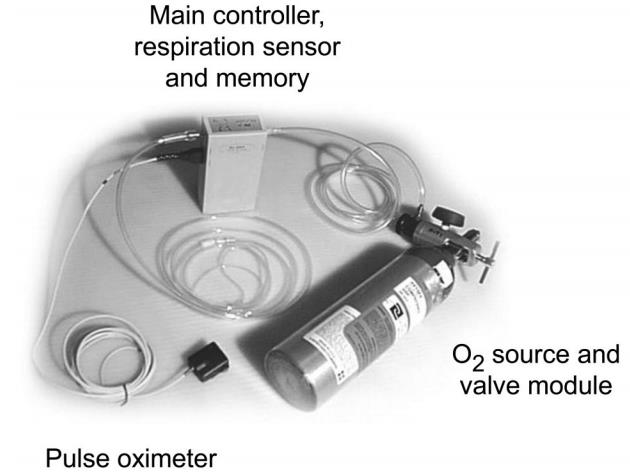OxyControl FichaEng
Contents
OxyControl
Objective
The idea is to control the flow of oxygen coming from a cylinder in an automatic closed loop system that continuously measures the saturation of oxygen (SpO2) in the blood thanks to a pulse-oximeter.
Motivation
Patients in oxygen therapy have to control the volume of oxygen received from their cylinders. Too little oxygen, hipoxemia, would cause dizziness and even loss of consciousness, too much oxygen, hyperoxemia, can cause intoxication.
Oxygen therapy is mostly practiced on newborn infants and on adults. The problem with newborns is particularly delicate as secondary effects of bad oxygenation can cause problems to the eyes, lungs and the central nervous system. In adults, the problem is mostly related to the periods of time when oxygen demand is higher than the average and the oxygen systems that are not controlled cannot react automatically.
Oxygen therapy is used in several hospitals units, during transportation and at home.
It is estimated that:
- More than a million of patients in USA are under long-term oxygen therapy (Long Term Oxygen Therapy, LTOT), whose cost is about 1.8 billion US$ [ref].
- In England 2 million treatments are provided during the transportation to the hospital [ref]
- In the world, tens of milions of people receive oxygen therapy every year[ref].
The majority of systems for oxygen therapy, especially home LTOT systems, are made for providing a continuous flow of oxygen between 0.2 and 15 liters per minute (lpm). Typically, a certain flow is prescribed on the basis of one single measurement of oxygenation with the objective of ensuring a 90% blood saturation. Sometimes a system for oxygen conservation is added to the cylinder, which harvests the gas based on the detection of inspiration-exhalation cycles.
The majority of medical guidelines for LTOT prescribe a flow of oxygen based on a 6 minutes assessment during moderate physical activity. Nonetheless, several patients at home can suffer from severe desaturations during sleep or during daily activities. These desaturations are not identified during the initial assessment. This suggests that it would be preferable to provide oxygen basing on the continuous measurement of oxygen saturation.
The objective of this system is to provide the right fraction of inspired oxygen (FIO2) by means of the measurement of the blood oxygen saturation with a pulse-oximeter.
The advantages of such system would be:
- It would minimize the episodes of desaturation.
- It would avoid excessive oxygen administration which could cause respiratory acidosis.
- It would customize flow supply according to the actual need of the patient, especially during physical activity and sleep.
In a first instance, we are targeting adult patients under home LTOT.
Existing systems
There exists a large variety of literature related to this subject. A recent paper that covers a vast number of clinical cases is this.
In this article some systems for closed loop control are mentioned, for hospital care, for newborns and for adults in home therapy. The most relevant example for our case is AccuO2. It is a system based on oximetry, developed by OptiSat Medical (The system is not on sale yet).

According to the pilots executed in Minneapolis Veterans Affairs Medical Center on 28 patients, the system is able to stabilize oxygenation better than a continuous flow of oxygen.
Another system is FreeO2, tested with healthy patients to which hipoxemia was induced with air and nitrogen. The system was developed in collaboration with the Laval University, Quebec.
Another similar system is O2 Flow Regulator devloped by Dima, Bologna, Italy. This system is meant for allowing chronic obstructive pulmonary disease patients under oxygen therapy doing exercise without entering in oxygen demand.
Methods and materials
For a first functional prototype we are employing:
- An Arduino board
- The Libelium eHealth shield for connecting a pulse-oxiemeter
- A proportional electro valve from Clippard
- A circuit for controlling the valve, from Clippard also
Results
We have all the pieces, we are calibrating the circuit for controlling the valve. After we will have to test the system with a flow meter and start some test with healthy human subjects.